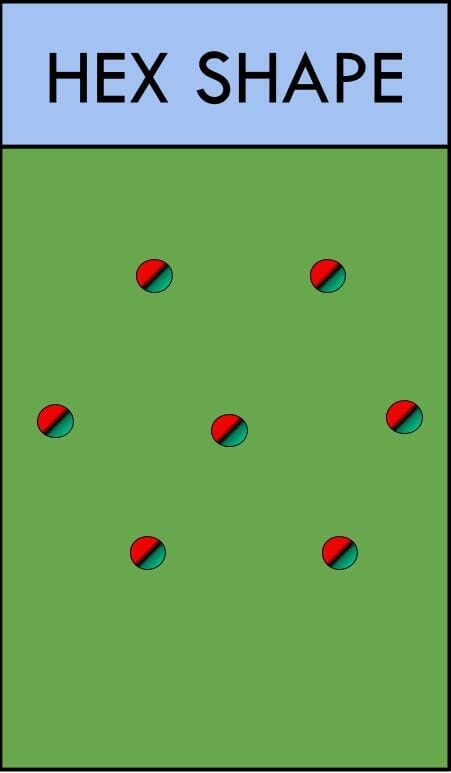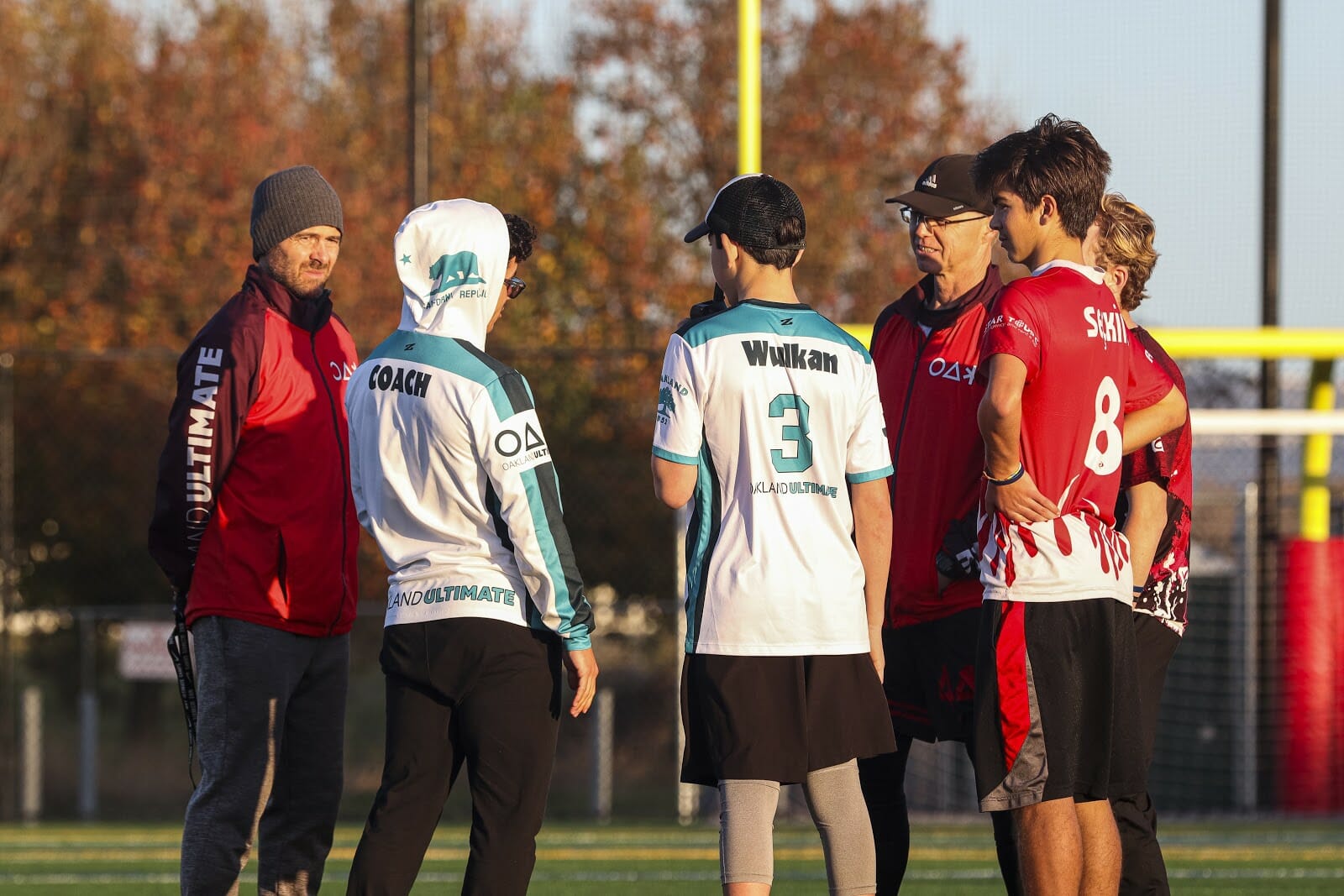Could this new offensive philosophy change ultimate?
January 28, 2021 by Valerio Iani in Analysis, Opinion with 0 comments
Laura Cincotta contributed to this article.
“You guys wanna see something new? Pass me that empty pizza box.”

I was in Italy for a fun reunion tournament, during a break between games with my old teammates on Canieporci Imola. As I started sketching an ultimate field and seven dots on a greasy cardboard pizza box, I saw puzzled looks around me. The seven dots were not in a line. This was neither vertical nor horizontal. The dots were scattered around the field — if you were to connect them, you would see a polygon. A polygon that nature knows well: a hexagon, the bestagon!
If you have an open mind, this may be the most important article about ultimate you read in this pandemic era. There’s a high probability you’ll soon find yourself enjoying the Hexagon offense (Hex) and its defensive counterpart, Flexagon (Flex). And if you don’t, quite surely you’ll play against it. So join me to take a peek.
What Is Hex and How Does it Work?
Hex is a new offense that moves away from conventional stack positioning. As in, you can forget horizontal, vertical, side, or split stack. Instead, imagine playing a 3v3-style keep-away game on a full size field. As Felix Shardlow–a coach and game analyst based in Brighton, UK, who coined the terms Hexagon and Flexagon–describes: “Hex is a naturally fast-paced offense, which flows organically, has limitless options, and is a lot of fun to play.”
Here are a couple examples of Hex in action:
Hex combines optimized spacing and completely flexible roles with a series of actions based on player decisions, resulting in a smooth ultimate offensive system. Unlike set plays that attempt to dictate flow, or standard offenses based on 1-on-1 isolations, Hex relies on players reading the defense throughout the possession and making the best play depending on the options available.
Hex does away with the traditional handler and cutter roles. The offensive players are distributed in a hexagonal shape around a central player. Rotating to maintain the hexagon shape, which can also be thought of as a cluster of equilateral triangles, all players are involved at all times. It doesn’t need to be a perfect or regular hexagon, but, with their teammates moving in that formation, a thrower should have five or six viable targets depending on where the disc is located. Hex allows for an endless number of potential plays, making it a deadly and unpredictable offense.

Hex is a high-tempo offense where most passes happen quickly, ideally within three seconds. Players seek fast, short distance passes or big hucks when viable, while the mid-range pass to “gain yards” is not an offensive goal.
These are some of the key tactics employed in Hex:
- Dribbling: The short-distance positioning and triangulation allows for refined and sustained give-and-goes known as “dribbling.” While a give-and-go is normally an isolated play between two players, dribbling is about ‘bouncing’ the disc rapidly off several teammates around you to attack the defense.
- Negative Space: The disc moves in all directions as the offense attacks the field vertically, horizontally, AND backward (“negative space”). Negative space adds a third dimension of passing opportunities and attack angles. Unlike in traditional offense, it’s not just a stall reset; these are intentional backward passes to redirect the flow.
- Inverted Pivot: Players make heavy use of the “inverted pivot” where, immediately after the catch, instead of rotating toward the expected sideline flow, the player looks for a quick infield continuation. This opens up options towards the center of the field.
- Quick Transition: As opposed to the “take a deep breath/call timeout” model after generating a block, Hex teams train to take advantage of the fastbreak.
Disc movement in Hex can be run continuously until it creates a flow and an open scoring opportunity presents itself. When I say flow, I’m thinking of Benji Heywood’s–Director of Ultimate, University of St Andrews in Scotland–brilliant definition: “Flow is having an open receiver somewhere, almost anywhere, on stall zero, before the force is set…Continuation cutting is not a race – it’s not a game of run & chase. It’s a game of information.”
Defenders against Hex will often find themselves on their heels, out of position, or off-balance, and with very little clue of what will happen next.
Can’t picture it yet? For you logic lovers, here is the disc movement decision tree:

Does It Really Work?
You might be thinking, “I don’t buy it. This isn’t new,” or “I’ve seen this before,” or “Even my team does some of this stuff.” And you’re half right. Many of the individual elements of Hex aren’t radically new, and many elite teams have been using them for years.
Japan’s Buzz Bullets are renowned for their fluid approach built around rapid disc movement and smart defensive switches. Seattle Sockeye made “small ball” famous. Raleigh Ring of Fire plays a powerful three-handler dominator weave. CUSB Bologna, who recently dethroned Europe’s long standing champ London Clapham, uses good spacing and interchangeable roles.
It’s not a coincidence that some of the most successful principles and tactics currently utilized by these teams are shared with Hexagon. It’s as if these top programs are leavening a dough that will sooner or later become a Hex pizza pie. As Colombia Revolution’s coach Mauricio Moore puts it: “We don’t practice literally Hex. But the things we do in a subtle way developed into some of the Hex principles…it’s pretty interesting.”
What makes Hex truly innovative is its holistic and unifying framework. To squeeze all the juice, you must switch your mindset and embrace a philosophy that runs counter to the way ultimate has been played for the last five decades. You must take an entirely different approach to teaching, training, and intentionally implementing the system.
You might also be thinking that Hex is too exhausting: playing 3v3-style on a full field for a whole game, let alone an entire tournament, is plain unsustainable, right? I had a similar reaction too, but after trying and training Hex, I realized it’s a matter of mental shift and efficiency. A new-to-ultimate athlete who comes from football and plays Ho-stack for the first time will run out of gas quickly. That’s not because they’re not fit but because they don’t know how to adjust to the type and timing of physical effort. The same applies when adopting Hex.
Here’s a case in point: A masters team full of dudes in their 30s that dares to play Hex on sand will collapse, right? Perhaps not. As Sjoerd Druiven, coach and member of the Dutch national beach masters team, shared after playing Hex at 2019 Beach Worlds: “In Hex, you are able to get the whole defense offset by one move and follow up. That’s very comfortable. Give me that all day long. Feels good thinking about it. And we played it a whole tournament. Every point. Easy. No injuries.”
More than physical, Hex is technical and tactical. Players must have high ultimate IQ and field awareness. The great thing is that, by playing Hex, players hone these very characteristics. They improve their decision making and build a rich throwing repertoire. This is particularly beneficial for youth who are learning the game with an eye to competitive play.
Ultimate is a young and growing sport. As players become stronger athletes, levelling the elite field, the greatest opportunities for developmental leaps will come from the technical/tactical realm. I believe the time is ripe for Hex to spread significantly in the upcoming years, with the potential to become a sport-transforming innovation.
What I Learned From Other Sports
Many mainstream sports–including ice hockey, basketball, and football (aka soccer)–had their own moment of breakthrough characterized by a tactical revolution. What I find intriguing is that the elements and contexts that led to these sports’ evolutions share many parallels with the Hex and with ultimate as we know it today. Follow me to review some of their fascinating history.
Ice Hockey and Moving the Puck
A major milestone in hockey’s development occurred when the Detroit Red Wings overcame many Cold War obstacles to recruit five young Russian talents who ultimately defected from the Soviet Union and often played as a unit under coach Scotty Bowman. Detroit’s historic 1995-96 NHL season was galvanized by the “Russian Five’s” fast-paced style, making the team a scoring machine and posting an amazing record of 62 wins. The following year, the Russian Five helped carry the Red Wings to their first Stanley Cup championship in 42 years. As Vassili Ossipov writes, the Russian Five “changed the fabric of hockey forever.”
“We dominated the game because this style was unusual at that time and teams didn’t know how to defend against the guys who constantly moved the puck around,” said Sergei Fedorov, member of the Russian Five.
I happened to watch the documentary “The Russian Five,” directed by Joshua Riehl, while munching pretzels on a transatlantic plane, and I highly recommend it if you want to learn more about an epic and tragic bit of sport history.
Basketball and Triangle Offense
Speaking of compelling documentaries, the recent “The Last Dance” about the Chicago Bulls dynasty was revealing for me because it presented a geometric affinity with Hex. I discovered that Michael Jordan wasn’t the only reason for the Bulls’ success in the 1990s. The “Triangle Offense” was a new strategy that helped Chicago, under head coach Phil Jackson, win two three-peats for a total of six championships. Jackson then brought the offense to the Los Angeles Lakers where he won five more NBA championships.
The triangle offense is considered the ideal way for five players to create space on the court and open many cutting opportunities. By filling those five spots, each player can pass to any of the other four. Every pass and cut has a purpose, and everything is dictated by the defense, just like in Hex.
The triangle offense has a pretty interesting history, starting with Hall of Fame coach Sam Barry at the University of Southern California in the 1930s and 1940s, a torch which was carried and refined by his pupil Tex Winter, who brought it to the Bulls in the 1980s and later to the LA Lakers in 2000s, in both cases as an assistant coach, mostly under head coach Phil Jackson. Between 1990 and 2010, the triangle offense was considered the most dominant offense in basketball. In recent years, the Golden State Warriors’ success was driven by coach Steve Kerr, a former member of that ‘90s Bulls team, who used a further evolution of the triangle, where the fast break is the number one option every time.
Football and Tiki-Taka
From one of my previous lives as a football coach, I know how much the sport pushes youth towards early specialization and how detrimental this is to their development. That’s why I love the idea of “Total Football,” which has even more elements of Hex.
Total Football is a fluid system in which no player has a predetermined role. You can start as a midfielder and find yourself playing as a defender or scoring a goal in a striker position. When you move out of a role, another player moves into it to maintain the team’s structure. Like Hex, “Total Football’s tactical success depends largely on the adaptability of each footballer within the team, in particular the ability to quickly switch positions depending on the on-field situation. The theory requires players to be comfortable in multiple positions; hence, it requires very intelligent and technically diverse players.” (Wikipedia, Total Football article).
From the 1930s to the 1960s, Total Football had a number of high-profile adherents around the world, including the Austrian Wunderteam, River Plate “La Maquina” from Argentina, the Golden Team of Hungary, Burnley in England, and Brazil’s Santos. It shot to popularity in the 1970s thanks to the Dutch, namely Ajax club and the national football team, and was further developed by Netherlands icon Johan Cruyff. In the early 2010s, the Total Football philosophy was revamped as “Juego de Posición,” or “Tiki-Taka,” by FC Barcelona and the Spanish national team, who won three consecutive major titles: Euro 2008, FIFA World Cup 2010, and Euro 2012. Tiki-Taka ruled the game because, on top of the interchangeability of players, it strategically maintained possession by working the ball with quick passes.
All these “sports breakthroughs” to a new model and pace of play arrived with fits and starts, often developing in unexpected ways, as we are likely seeing the first steps in ultimate.
Hex Around the World
In the early ’90s, Frank Huguenard envisioned a different style of ultimate, a philosophy he later developed and called “Motion Offense.” Huguenard’s effort to promote his offense sparked curiosity but didn’t catch on. More recently, the concept became more clear and approachable through the work of Felix Shardlow, who, in 2012, revived and rebranded it with the name Hexagon, cultivating an enthusiastic community of coaches.
Today, the seeds of Hex are growing everywhere. People are ready to experiment and want to know more. Teams around the world from all divisions have started to engage with Hex by rethinking and redesigning their practice plan and game strategy.
The Sussex Hawks team, who won the UK University Men’s Indoor Nationals in 2019, was the first team to train Hex under coach Shardlow, who remembers: “My entire approach to training changed. Older drills with underlying stack/iso/1-to-1 ideas became less applicable, and more dynamic approaches to learning technique, movement, and spacing habits came to the forefront.”
On the other side of the Atlantic in New Jersey, US, another college team, Stevens Tech, also plays Hex. Jason Thompson, who introduced Hex during the 2018-19 season, when the team took 3rd at D-III College Regionals, said: “One thing I really like about Hex as a coach is I almost never have to talk about the other teams’ defense to correct our offense in the huddle. I can just point out which principle they are neglecting the most and the problem is solved.”
In New Zealand, Hamish Furniss was responsible for bringing Hex to the country, as his club Hammertron made a splash with their mixed team Prime finishing 3rd in the last two Nationals. “There has been an increase in scouting and analysing of our Hex by other teams,” he said. “The mold in NZ has been broken and teams are looking at ultimate with fresh eyes.”
In South Africa, Hex has helped Cape Town’s Catch 22 (mixed) and Homebru (men’s) break away from the pack. Coach Nick Zaloumis shares how Hex supports team depth: “Hex being a dynamic offence allows you to utilize strengths in your team a bit more than some conventional offenses. Players get more touches on the disc because of the flow this offense encourages, this then can translate to general confidence and involvement in the game.”
In Germany, Hex was instrumental to Goldfingers Ultimate Club’s success in the Open, Open Masters, and Mixed Masters divisions. They started using Hex in 2016 and have been dedicated to it ever since. “We even moved away from most of our setup plays and only sprinkle them in once or twice in a game,” said coach Kim Gietzen. “If we manage to keep our flow, then no defense in this league is prepared to hold anything against it. I don’t wanna say we mastered this strategy but we are no longer rookies since we overcame our old problems, like getting stuck on the sideline, and started to stumble across new ones like how to bring ourselves backwards to a more comfortable position to score.”
Playing Hex doesn’t alway provide instant gratification; it takes time and continuity, like any offensive system. Callum Spiers coached the Great Britain U24 Mixed team in 2018 and 2019, as well the Women’s squad at the 2019 European Ultimate Championships. “I’ve only had one season with each team to convey what we’re trying to achieve, and not using Hex as our only offence,” he said. “This means that we just haven’t had the reps for people to try it out and get to grips with it. It’s a big set of ideas that run counter to some ways of playing ultimate. Some players learn it quickly and others struggle with it.”
Despite the challenges, coaches are having good experiences implementing the philosophy and are excited to introduce Hex to other teams. Coach Leo Sonneveldt used Hex O for one of the Dutch U24 Mixed D-lines at Worlds: “Hex equalizes players within a team. I have always liked switching players all over the field and that is what Hex does in my eyes. Yeah I love Hex, but even more I love the principles behind it.” Sonneveldt now plans to bring the U20 Dutch Women on the Hex train.
As a matter of fact, the youth scene is burgeoning with interest in Hex. Despite the advanced level and complexity of this system, Hex teaches the game of ultimate to kids the right way, giving them a skill set that is primed for high competition, and additionally makes them agents within the coach-player dynamic. “It has created a really wonderful collaborative atmosphere,” said Michelle Steele, coach at Middlebury Union High School in Vermont. “We are problem solving and crafting our new offense together, and while I am still the coach, it has given the players a new sense of autonomy and motivation to really understand the techniques/strategy behind what we are doing. Instead of just cutting where I tell them to in a ho-stack, for example, they are more willing to actively experiment and learn in a new and creative way.”
How I Started
This boost in problem solving, engagement, shared responsibility, and creativity is what I have also encountered in my personal experience teaching Hex. When I first read about Hex, it looked interesting but, comfortable with my knowledge of the game, it didn’t seem worth it to revolutionize everything just to try such an unconventional and abstract system.
Nevertheless, I was frustrated with the flaws I saw in the “simple to complex” linear process coaching model, where skills acquisition is based in isolation and repetitions. The competitive game IQ was either missing entirely or it took a very long time to reach it.
When I founded my youth club Oakland Ultimate in 2017, I finally had the freedom to try a totally different approach. I started embracing what I call the “simplicity of complexity” (better known as “ecological dynamics”) that, put simply, means creating an environment where players solve problems. I wanted to train the way we play the game and build multi-functional players for whom “direct perception becomes a habit,” as Spanish field hockey coach Andreu Enrich puts it.

Targeted to middle school players, the very first program I ran that year had three mandates: positive attitude, completions, and the quick transition. Rather than working on O and D separately, I instructed players to focus on quick transitions from offense to defense and defense to offense. I placed emphasis on field vision, flexibility, and decision making in particular. I encouraged players to play all roles, use all sorts of throws, and accept challenges with a growth mindset.
From this initial reframe, more adjustments followed. The developmental programs and traveling team practices started to look quite unorthodox:
- Warmups were always moving around with a disc in hand (Video)
- Dynamic opportunities for creativity and unconventional throws replaced classic 2-person throwing exercises (Video)
- The concept of “clear after your cut” was replaced by “offer continuous cutting options” (Video)
- “Dump” and “reset” were upgraded to a more aggressive “start-a-flow” mentality (Video #1, Video #2)
- Situational plays with varying levels of defensive pressure and a stall count took the place of “drills” (Video #1 , Video #2)
- Full-field 7v7 scrimmages became rare, substituted by small-sided games: 2v2, 3v3, 4v4 and 5v5 intense games (Video)
- Mental training was included at each session
As I revolutionized my coaching and practice structure with these adjustments, I realized I was basically training for Hex, and I dug down to learn more. I revisited the ultimate sphere–all the game footage, dynasties, threads and patterns–through the lens of Hex, and it became clear that this would become our way to play. However, I felt that implementing Hex full bore was going to be a hard sell to young players who were “training” for Hex in our club but still carried in their minds the traditional stack paradigm from their school teams.
So here comes the million dollar question: Does the hexagon shape dictate how you play, or does the way you play lead you to the shape? Are bees hardwired to create hexagons or is it the shape’s functionality that inspires the bees to form that specific cell shape in their honeycomb? For me, it happened backward–the shape was the last adjustment I made.
To transition to Hex, I came up with the idea of developing a 3-on-3 flow offense that we called the “Kitchen.” A “Butcher” hovered between two sets of two “Knives” on either side of the field, while two “Steamers” were the deep cutters. By connecting with either of the two pairs of Knives, the Butcher formed a triangle that created 3v3 opportunities. It wasn’t easy for the players (who still sometimes asked to play horizontal with Kitchen as just the surprise offense), but they eventually understood the power of immersing themselves in a novel and unexpected playing style.
This hybrid ‘Hex’ offense led our U17 team to a successful showing at the 2019 Youth Club Championships, where we made the top 10 in the country with a very young team that the year prior placed second to last. Everyone was feeling good about how well the Kitchen worked and was psyched to show off the next year. Instead, when we got home, we surprised the team: “Forget about the Kitchen, we’re upgrading to Hexagon!”
“The change was confusing at first,” remembers Greg Klunder, one of my coaches. “As we worked on it, there was a better understanding and an increased comfort level. Our first test for the Hex offense was a college tournament and, yes, we were still a U17 team. Our offense took teams by surprise and we were able to finish in the middle of the pack at a college tournament…We experienced more balanced scoring so that everyone on the field is a threat.”
Then the pandemic arrived and our date with Hex destiny went on indefinite hold. However, in less than three years, we were able to turn a ragtag group of beginner middle schoolers into a solid team of capable young athletes with a deep understanding of the game. I’m convinced that their rapid learning and meteoric achievement was thanks to the abstract reasoning and mind-broadening that the Hexagon offense brings.
It’s been a heck of a journey. I’m glad that I have been able to see ultimate with new eyes and that I encountered Hex to challenge my view of the sport and how to teach the game. I’ve found it fulfilling to experiment with Hex, and I believe many smart and curious coaches will enjoy it too.
What Happened To the Pizza Box?
A few months after the Canieporci reunion and pizza sketch, my friend and veteran player Andrea Dalfiume texted me that the team debuted the Hex at a local beach tournament. They managed to beat everyone and only lost in the rematch final against historic powerhouse Cotarica Rimini. “Playing Hex was crazy fun,” he wrote. “When it works smoothly, you feel unstoppable!”
So go get your mind in shape and may you have many unstoppable moments with the bestagon.
